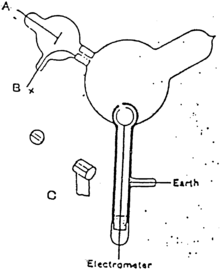The Thomson Medal and Prize is an award which has been made, originally only biennially in even-numbered years, since 2008 by the British Institute of Physics for "distinguished research in atomic (including quantum optics) or molecular physics". It is named after Nobel prizewinner Sir J. J. Thomson, the British physicist who demonstrated the existence of electrons, and comprises a silver medal and a prize of £1000.[1]
| Joseph Thomson Medal and Prize | |
|---|---|
| Awarded for | Atomic physics |
| Sponsored by | Institute of Physics |
| Presented by | Institute of Physics |
| Reward(s) | Silver medal, £1000 |
| First awarded | 2008 |
| Website | http://www.iop.org/about/awards/ |

Not to be confused with the J. J. Thomson IET Achievement Medal for electronics.
Medallists
The following have received a medal:[2]
- 2022: Michael Tarbutt, for pioneering experimental and theoretical work on the production of ultracold molecules by laser cooling, and the applications of those molecules to quantum science and tests of fundamental physics.[3]
- 2021: Carla Faria, for distinguished contributions to the theory of strong-field laser-matter interactions.[4]
- 2020: Michael Charlton, for scientific leadership in antimatter science.[5]
- 2019: Simon L. Cornish, for outstanding contributions to experiments on ultra-cold atoms and molecules [6][7]
- 2016: Jeremy M. Hutson, for his pioneering work on the theory of ultracold molecules [8][9]
- 2014: Charles S Adams, for his imaginative experiments which have pioneered the field of Rydberg quantum optics[10]
- 2012: Michael Köhl, for his pioneering experimental work in Bose-Einstein condensates and cold Fermi gases
- 2010: Gaetana Laricchia, for her contributions to the development of the world's only positronium beam[11]
- 2008: Edward Hinds, for his important and elegant experimental investigations in the fields of atomic physics and quantum optics[12][13][14]
See also
References
🔥 Top keywords: Main PageSpecial:SearchIndian Premier LeagueWikipedia:Featured picturesPornhubUEFA Champions League2024 Indian Premier LeagueFallout (American TV series)Jontay PorterXXXTentacionAmar Singh ChamkilaFallout (series)Cloud seedingReal Madrid CFCleopatraRama NavamiRichard GaddDeaths in 2024Civil War (film)Shōgun (2024 miniseries)2024 Indian general electionJennifer PanO. J. SimpsonElla PurnellBaby ReindeerCaitlin ClarkLaverne CoxXXX (film series)Facebook2023–24 UEFA Champions LeagueYouTubeCandidates Tournament 2024InstagramList of European Cup and UEFA Champions League finalsJude BellinghamMichael Porter Jr.Andriy LuninCarlo AncelottiBade Miyan Chote Miyan (2024 film)